Welcome
Welcome to Virtual Consultation & Engagement Event 2 for the Environmental Assessment (EA) Terms of Reference of the Twin Creeks Environmental Centre (TCEC) Landfill Optimization Project
This Virtual Consultation & Engagement Event is being held to present:
- An overview of the project
- The development and contents of the Terms of Reference (ToR)
- The EA process
- Information on the:
- Rationale for the project
- Proposed alternatives
- Evaluation process and criteria
- Consultation and engagement process
We are looking for your feedback on:
- Your interest in the project
- The format of this event
- Current site operations
- The rationale for the project
- Proposed alternatives and evaluation criteria
- General study areas and proposed discipline-specific studies
- The consultation and engagement program
- Other considerations for ToR development

About Twin Creeks
About the Twin Creeks Environmental Centre
The Twin Creeks Environmental Centre (TCEC) is a regional facility that provides safe and convenient disposal services for communities, businesses and industries serving the Province of Ontario. The landfill is approved to receive municipal, industrial, commercial, and institutional solid non-hazardous wastes generated, including non-hazardous contaminated soil.
The TCEC is engineered with environmental protection systems that meet or exceed regulatory requirements and are subject to highly regulated monitoring and reporting requirements. Systems include engineered liners and covers, leachate collection and removal, landfill gas collection and control, and on-site leachate disposal through phytoremediation.
The TCEC provides landfill gas, for heating, to the 40-acre greenhouse facility adjacent to the landfill property. Prior to this, all landfill gas was flared. The intent is for the landfill to supply gas for heating to the greenhouses for 25 years.
Leachate that is generated in the waste is conveyed toward a perimeter leachate collection system. WM received approval to treat leachate through a phytoremediation system consisting of a 9.3 ha poplar system planted on the existing landfill cap in 2003. Surplus leachate is trucked off-site to approved wastewater treatment plants.
WM pays host community fees annually to the Township of Warwick. Since 2009, when the TCEC Expansion Landfill began receiving waste, WM has contributed over $24M in host community fees and municipal property taxes to the Township.
| Twin Creeks Environmental Centre Overview |
|---|
| Year Opened 1972 |
| First Year Operated by WM 1996 |
| Projected Life Remaining 10 years |
| Total Area 301 ha |
| Permitted Landfill Footprint 101.8 ha |
| Remaining Capacity 15M m³ |
| Annual Fill Rate 1.4M tonnes/year |
Project Overview
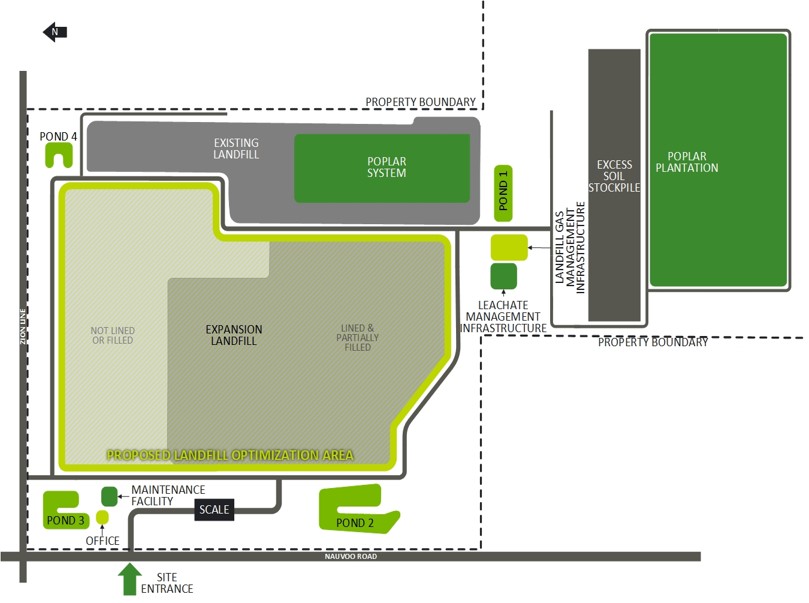
The purpose of the proposed project is to optimize the Expansion Landfill design and operation, maximizing the use of the constructed infrastructure and significant investment made at the TCEC.
The optimization could involve a vertical expansion of the landfill within the Expansion Landfill footprint by modifying the sideslopes and increasing the elevation of the landfill.
This optimization could provide additional airspace of up to approximately 14M m³, and extend site life by approximately 12 years (from 2031 to 2043).
There would be no change to the:
- current 101.8 ha landfill footprint area
- approved service area
- annual fill rate
Environmental Assessment Process
The first step in the Environmental Assessment (EA) process is the preparation of a Terms of Reference (ToR), which requires approval by the Minister of Environment, Conservation and Parks.
The ToR will set out the framework and work plan for addressing the Ontario Environmental Assessment Act requirements when preparing the EA, including:
- Rationale for the project
- Alternatives that will be considered
- Public consultation and engagement activities that will be carried out
The EA will be carried out in accordance with the requirements of the Ontario Environmental Assessment Act and the approved Terms of Reference and conditions of approval.
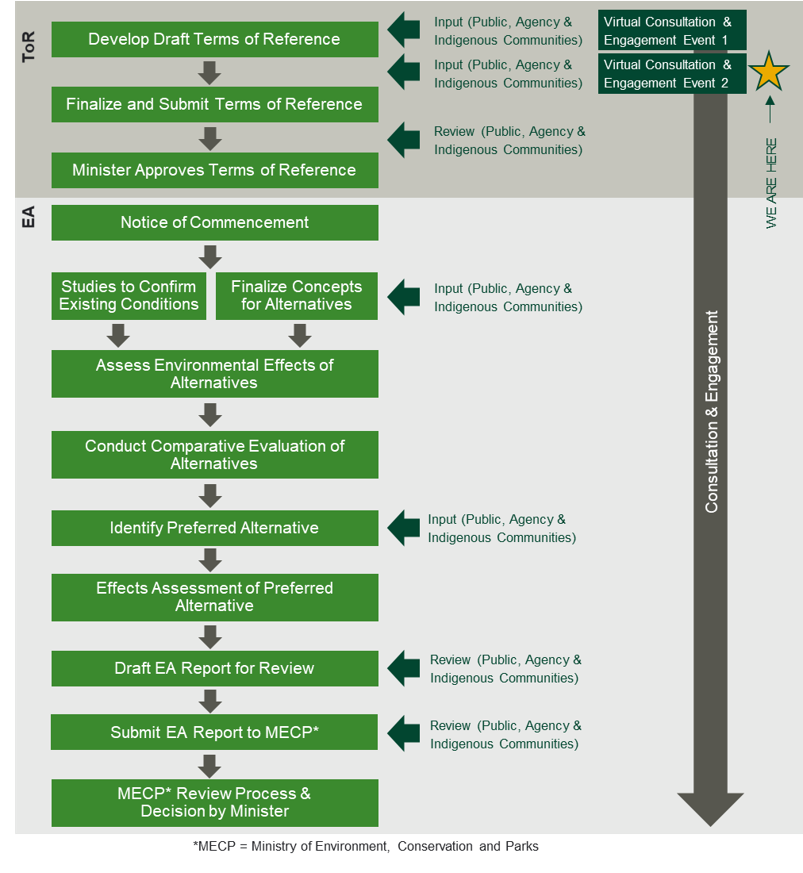
Rationale for the Undertaking
- There is a need for the continued development of the TCEC. The TCEC is a significant component of the provincial waste management network and infrastructure, which is lacking in sufficient and secure long-term disposal capacity.
- The Ontario Waste Management Association has estimated that there is only 15.5 years of disposal capacity remaining in Ontario.
- There are three large private landfill sites in southern Ontario, including the TCEC, all operating at their approved annual limits.
- Continued operation of the TCEC aligns with the Province of Ontario’s Strategy for a Waste Free Ontario, Climate Change Action Plan goal of reducing GHG emissions, and the Made in Ontario Environment Plan to reduce litter and waste in communities.
- Approximately 2.5M to over 3M tonnes of post recycling and diversion residual waste generated in Ontario is disposed of in Michigan each year.
- The TCEC receives 1.4M tonnes of post recycling and diversion residual waste. Approximately 20% is managed directly by WM with the remainder controlled by third parties.
- Optimizing the future development of the TCEC allows for on-going sustainable business operations and continued provision of essential financial support for community services and programs.
Based on current landfill operations and waste configuration (i.e., side slopes and final elevation), the EA approvals process must be started now to have the necessary approvals in place to allow for an efficient implementation of the landfill optimization project. This will also provide longer-term certainty of service continuity to WM’s customers beyond the remaining 10 years of capacity.
Alternatives to the Undertaking
WM has identified a range of ‘alternatives to’ the undertaking (or project) for providing additional long-term disposal capacity that would be appropriate and reasonable for them (a private sector company) to implement.
- Do nothing – this is the status quo and the existing approved airspace capacity would remain unchanged.
- Redirect waste to a disposal facility elsewhere (transport material to other approved disposal facilities in Ontario and/or the U.S.).
- Develop a new WM disposal facility (establish a new disposal facility in an area capable of serving the customer base of the TCEC).
- Develop additional disposal capacity via landfill optimization at the TCEC within the currently approved Expansion Landfill footprint of 101.8 ha.
- Develop additional disposal capacity within the 301 ha TCEC including areas outside of the Expansion Landfill footprint.

The ‘alternatives to’ were considered in the context of their ability to address the business opportunity identified by WM.
Landfill optimization within the Expansion Landfill footprint (Alternative 4) is the only reasonable option for WM. This alternative will:
- Optimize the current landfill design and operation.
- Maximize the use of the constructed infrastructure and significant investment made at the facility.
- Avoid constructing on-site on top of previously-closed landfilled areas or closer to Watford.
- Avoid constructing a new landfill elsewhere, or the added financial implications and emissions associated with waste transport.
The other alternatives do not address WM’s business opportunity to meet long-term customer commitments, do not avoid business risks or maximize the financial investment in the facility, and limit the benefits provided to the local community.
Alternative Methods
Alternative methods are different ways of implementing the preferred ‘alternative to’ the proposed undertaking (project).
The landfill optimization would involve a vertical expansion within the current Expansion Landfill footprint by modifying the side slopes and increasing the elevation of the landfill.
The approved airspace capacity within the Expansion Landfill is achieved with 4:1 side slopes to an elevation of 265.7 metres above sea level (masl) and then with 20:1 side slopes up to the landfill peak elevation of 278 masl. A two-metre-thick cover results in a landfill peak of 280 masl. The existing ground elevation in the area is approximately 245 masl.
Alternative methods for vertical expansion may include:
- 4:1 side slopes to 300 masl, then 20:1 slope to peak (304 masl)
- 3:1 side slopes to 300 masl, then 20:1 slope to peak (307 masl)
- 4:1 side slopes to 320 masl (peak)
- 3:1 side slopes to 320 masl, then 20:1 slope to peak (324 masl)
The optimization of the approved Expansion Landfill could provide additional airspace capacity of up to approximately 14M m³.
WM completed a geotechnical feasibility review of the alternative methods, which confirmed that the range of alternative methods are acceptable as follows:
- Post-settlement landfill base grades meet regulatory requirements and maintain acceptable leachate collection in the primary leachate drainage layer
- The combination of final side slopes and proposed peak elevation are stable
- The strength of the primary drainage layer collection pipes is acceptable
- The flow capacity of the geonet within the secondary drainage layer will meet the design requirements
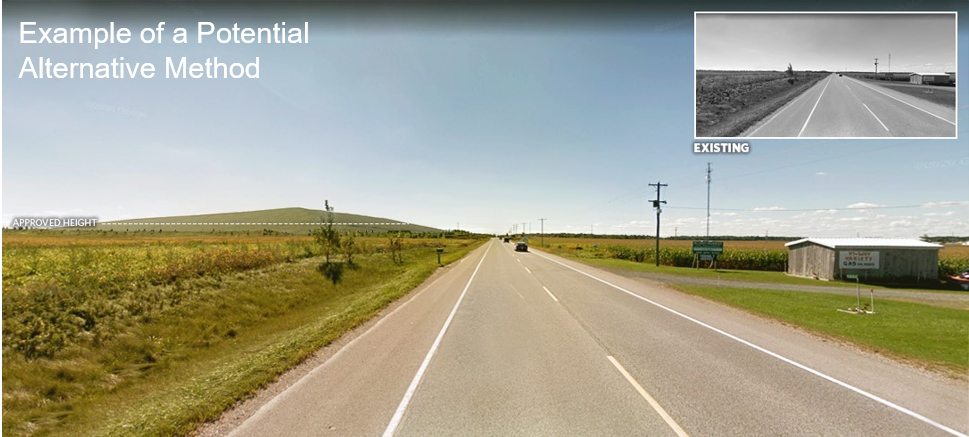
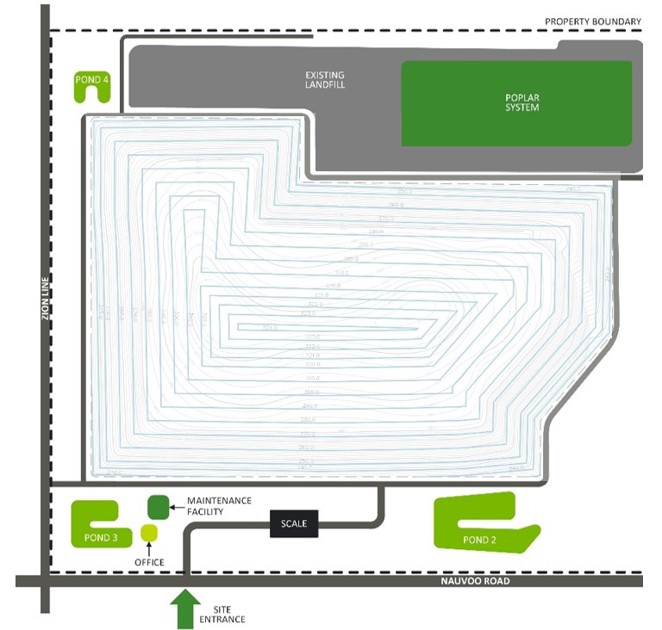
Evaluation Process and Criteria
The proposed evaluation process for the EA includes:
- Describing the environment potentially affected (existing conditions) based on evaluation criteria
- Describing the conceptual design details for the alternative methods (i.e., various slope and peak scenarios), including mitigation measures
- Predicting the environmental effects from each alternative method based on evaluation criteria
- Refining mitigation measures and predicting net effects on the environment
- Comparatively evaluating alternative methods based on evaluation criteria
- Identifying the preferred alternative
- Conducting an effects assessment of the preferred alternative method
- Consideration of cumulative effects and climate change
Proposed evaluation criteria will consider potential effects on:
- Natural Environment
- Atmospheric Environment (Air Quality, Noise, Odour, Litter)
- Geology, Hydrogeology, and Groundwater (Quality and Quantity)
- Surface Water Environment (Quality and Quantity)
- Ecological Environment (Terrestrial and Aquatic Ecosystems)
- Socio-Economic Environment
- Economic Environment
- Local Community
- Visual Landscape
- Cultural Environment
- Archaeological Resources
- Cultural Heritage Resources
- Built Environment
- Transportation
- Current and Planned Future Land Use
Study Areas and Supporting Studies
Potential effects will be considered in terms of on-site and off-site study areas. The proposed on-site and off-site study areas for the EA are:
- On-site study area: the existing TCEC;
- Off-site study area: the lands within the vicinity of the TCEC extending approximately 1 km out from the On-site Study Area.
The off-site study area may be refined during the EA to suit the requirements of a specific environmental component or based on the spatial extent of predicted effects.
Discipline specific studies will be carried out, as required, to obtain information for the assessment of alternatives based on the evaluation criteria, considering the:
- Description of the environment potentially affected
- Prediction of potential effects on the environment for each alternative
- Identification of mitigation measures and potential net effects on the environment for alternatives considered
- Comparative evaluation of the alternatives
Work plans for the discipline-specific studies have been prepared and are appended to the Draft Terms of Reference for review.
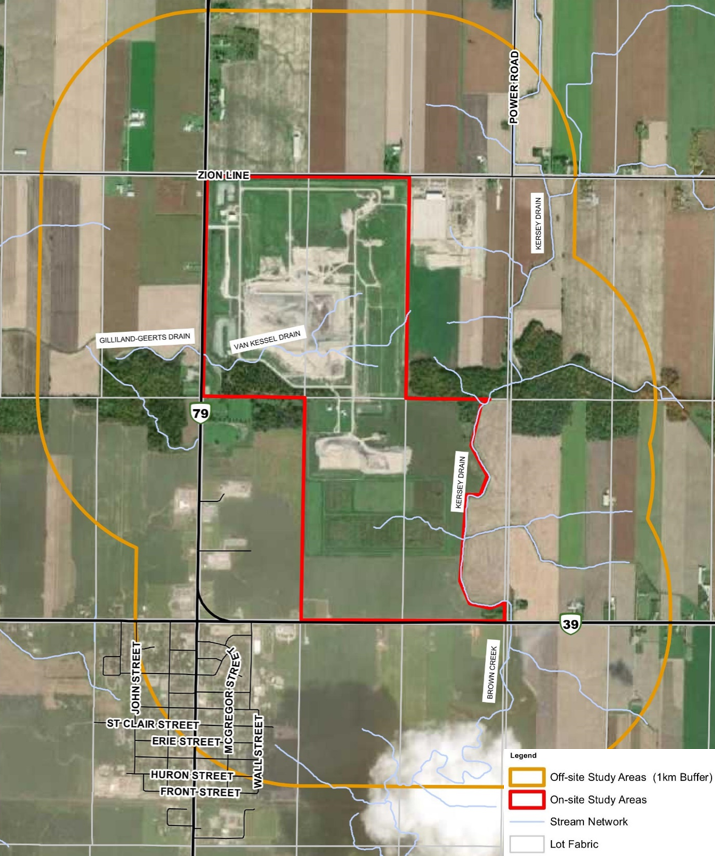
Consultation and Engagement
Members of the public, agencies, Indigenous communities, and other interested persons are encouraged to actively participate in the planning process by participating in consultation and engagement opportunities or contacting staff directly with comments or questions.
Consultation and engagement to-date has included:
- Notifications through newspapers, e-mail, and direct mail
- Virtual consultation and engagement events
- Project website, contact e-mail and telephone number
- Consultation with agencies and the public
- Engagement with Indigenous communities and groups
- Municipal Council meetings
- Warwick Public Liaison Committee meetings
- Phone calls
- Media publications
Consultation and engagement will continue during the EA process and will be advertised in local newspapers, on the project website, and by direct mail and/or e-mail.
While the COVID-19 pandemic is limiting our ability to meet with you in person to discuss the project, WM is committed to on-going consultation and engagement with our neighbours and anyone with an interest in the project. We will be working to determine how best to conduct these activities in a way that is respectful of personal safety and physical distancing guidelines.

Next Steps
Input received through this virtual consultation and engagement event and other comments received will be used to develop and refine the proposed Terms of Reference for the EA.
The Terms of Reference will be finalized and submitted to the Minister of Environment, Conservation and Parks. A review period will follow the submission prior to the Minister’s decision.
If the Terms of Reference is approved, WM will commence the EA for the project.
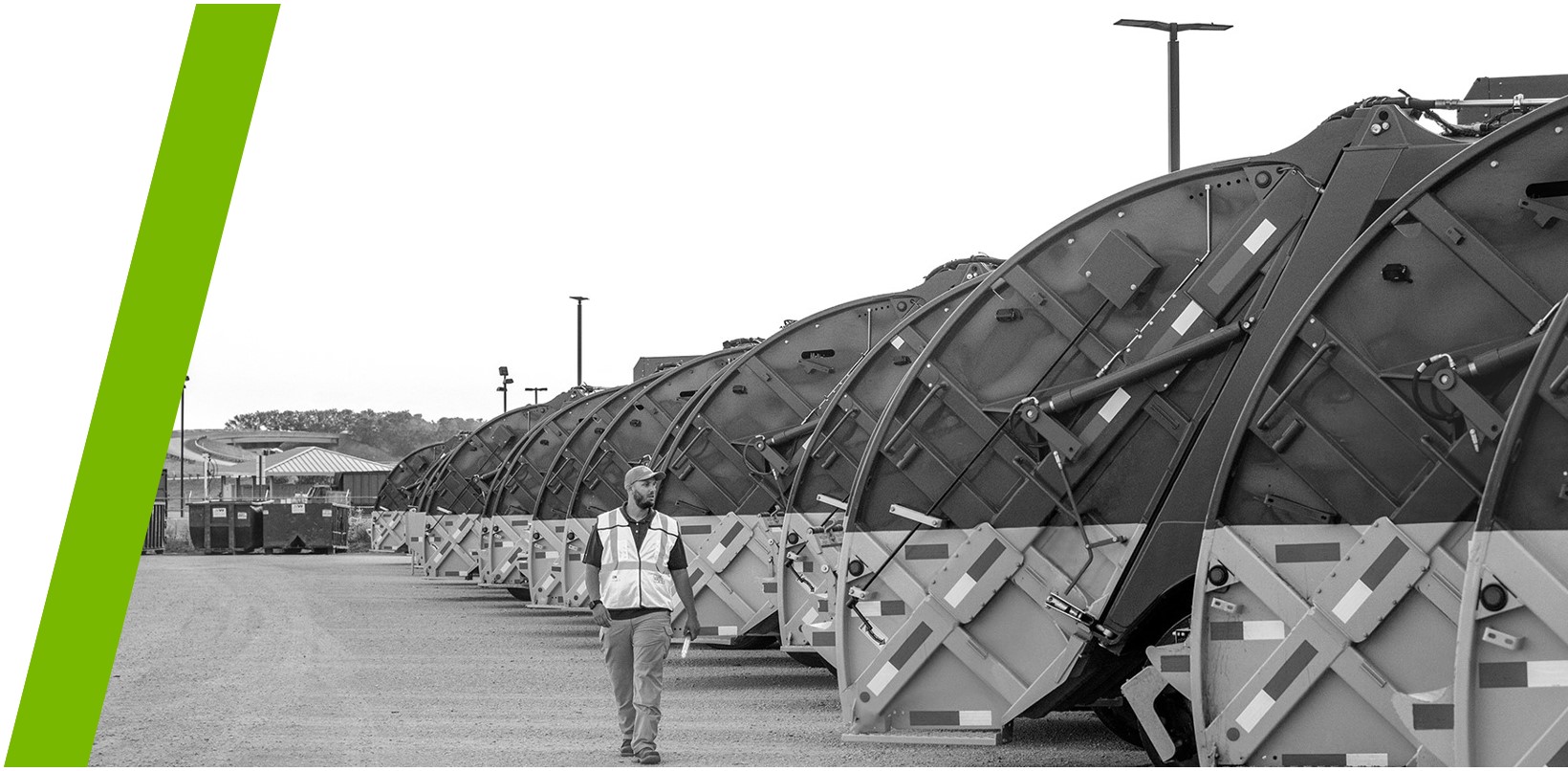
Stay In Touch
Join the Mailing List
Join the Mailing List to receive Project updates:
Get in touch with us about the Project:
Wayne Jenken
Area Landfill Manager, Eastern Canada Area
Waste Management of Canada Corporation
5768 Nauvoo Road, Watford, ON N0M 2S0
wjenken@wm.com
519.849.5810
Larry Fedec, P.Eng., MBA
Solid Waste Program Lead, Canada
HDR Corporation
100 York Blvd., Suite 300, Richmond Hill, ON L4B 1J8
larry.fedec@hdrinc.com
289.695.4696
Submit a Comment
Fill in a Comment Form and let us know your thoughts. Contact information provided may be used by WM to respond to your comments.
* All personal information included in a submission – such as name, address, telephone number and property location – is collected, maintained and disclosed by the Ministry of the Environment, Conservation and Parks for the purposes of transparency and consultation. The information is collected under the authority of the Environmental Assessment Act or is collected and maintained for the purpose of creating a record that is available to the general public as described in s. 37 of the Freedom of Information and Protection of Privacy Act. Personal information you submit will become part of a public record that is available to the general public unless you request that your personal information remain confidential. For more information, please contact the Ministry of the Environment, Conservation and Parks’ Freedom of Information and Privacy Coordinator at 416-327-1434.
